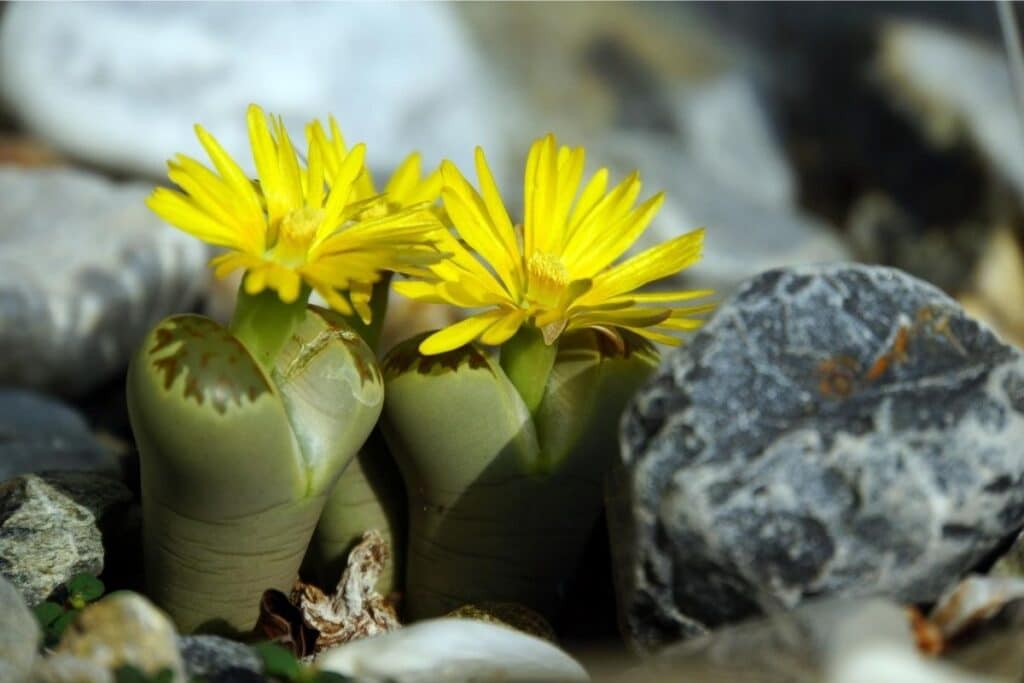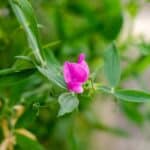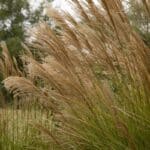If you’re looking for something unusual to grow, you should consider the living stone plant. As the name suggests, this plant resembles small stones which makes it difficult to notice in the wild. When grown for ornamental use though, the plant becomes a definite showstopper.
This strange-looking plant may need special attention to grow indoors but the peculiarity of the living stone plant makes all the effort worth-while.
What is a Living Stone Plant?
William John Burchell, an English naturalist and author first stumbled upon a plant in the arid regions of South Africa in 1811 (1).
Camouflaging with the tiny stones on the ground, the plant has two thick leathery gray-green leaves that look like a stone with a flat top cracked in two.
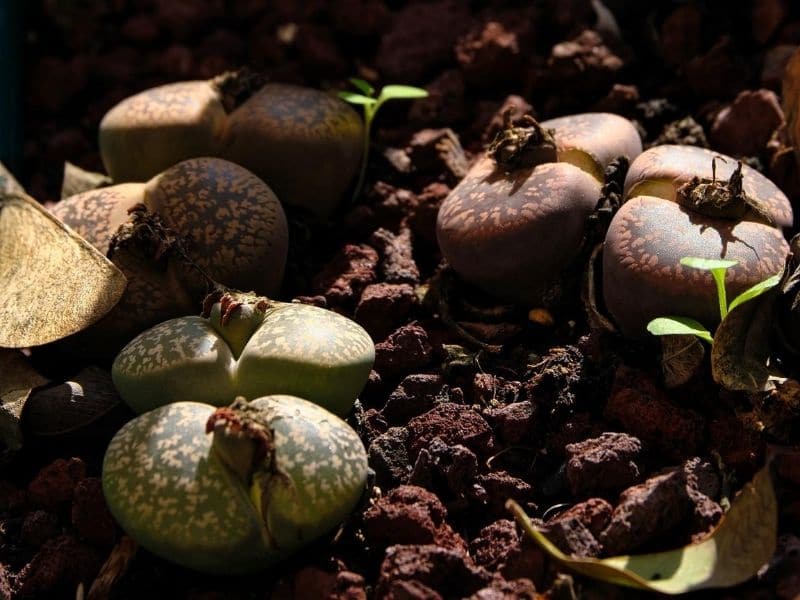
The plant became known as ‘living stone’ because of this as well as ‘belly plant’ due to the need to lie and crawl on your belly to see the plant. It was in 1922 when the plant was finally given the botanical name, Lithops which is Greek for ‘stone-like’ (2).
In its naturally dry environment, the two succulent leaves of living stones allow them to minimize water use as well as store enough moisture for the months when there is no rain.
These leaves are halfway buried into the soil together with a simple network of roots as a way to survive the extreme climate.
By keeping a low profile, the plants avoid being eaten by grazing animals looking for moisture during drought. But come autumn, a white or yellow daisy-like flower emerges in between the leaves for 4-5 days, revealing the existence of lithops in the wild (2).
Do Lithops Multiply?
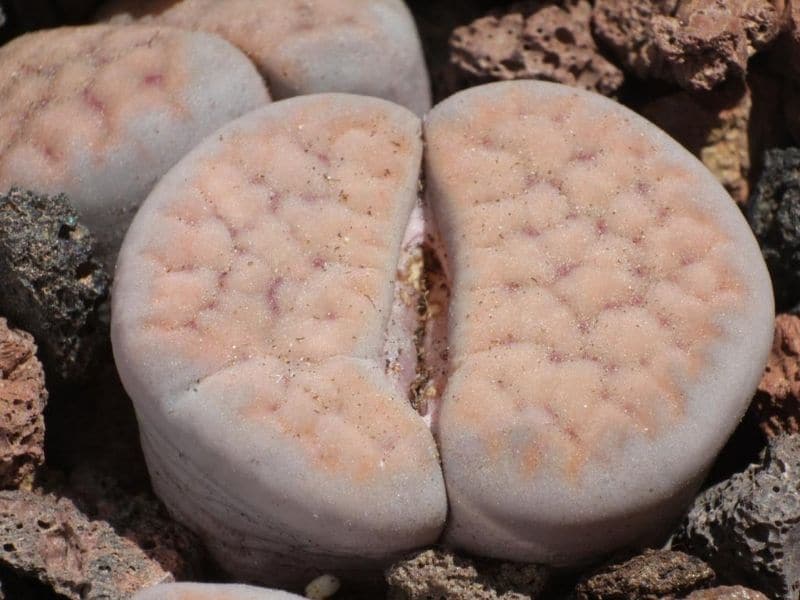
Matured lithops, the ones that have been around for 3-4 years, produce a new pair of leaves once a year, usually in spring. The new leaves slowly push out from the fissure parting the two old leaves which will eventually wilt and dry.
At the same time, some species will divide and produce two pairs of leaves in a single plant and this will eventually grow into a small cluster.
Are Living Stone Plants Poisonous?
Living stone plants are non-toxic. In South Africa, the plant is consumed as a source of moisture in areas where water is scarce. They are safe to ingest but are expensive and difficult to grow so put them in a location out of reach of children and pets.
How to Care for Lithops
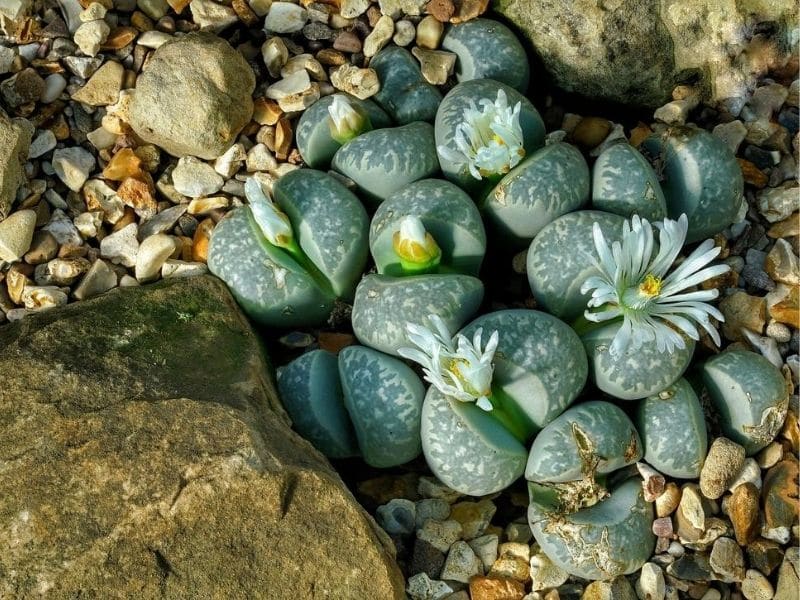
Light
A native of sunny arid regions, lithops are used to intense sunlight. Those that are grown indoors should receive 4 to 5 hours of direct sunlight and partial shade in the afternoon (1). A south-facing window is an ideal location but any area receiving just enough natural light is okay.
Living stone plants are particular about the light indoors. If exposure to sunlight is too little, they will elongate, leaning to the side where the light source is. Variegation and discoloration will also disappear leaving the plant dull green.
Newly bought living stones have been acclimatized to a more shaded environment so even though they can protect themselves from overexposure to sunlight, their resistance to bright light is diminished. Sudden brightness will cause the plant to burn and leave a white scar on the leaves so make sure that the change in indoor light setting is gradual.
Water
Living stones are well adapted to drought but watering them indoors will require special attention and their growth cycle must be considered. They become dormant during summer and although the leaves are still intact, they do not need a lot of water. If they start to shrivel, wet only the top ½ in of the soil.
Lithops often start to flower in autumn and since this plant process will use up the plant’s reserves, thorough watering should be done. Make sure that the soil has dried out before the next watering. A well-draining soil mix is important because any medium that gets soggy will only lead to bursting of leaves and even rotting of the plant.
As winter approaches, watering should be decreased and eventually stopped. The plant will continue growing and will start using up the moisture reserves in preparation for the regrowth of leaves come spring. Water again like in autumn when the leaves have dried and turned papery shells.
Temperature and Humidity
Generally, living stones survive in warm temperatures and low humidity but some species are more tolerant than others. A study showed that L. turbiniformis cannot withstand 45 degrees C while L. lesliei tolerated 56 degrees C. Some species can even survive -10 degrees C (1)!
These differences may be attributed to the locations where the species grew but all of them, if not subject to the extremes, will survive in the indoor setting. A temperature lower than 5 degrees C will definitely damage and kill off most lithops species. If temperature becomes too high, make sure that there is fresh moving air to keep the plant cool.
Pest and Diseases
Mealy bugs and spider mites are common pests that attack living stones. They are often seen attacking the base, in between the leaves, and the roots of the plant leaving tiny white scars and shrivelled leaves. These can be controlled by application of horticultural oils and insecticide but only use them at the recommended rate.
Diseases like soft rot and bursting of leaf bodies are due to overwatering so the only way to prevent these from happening is to closely monitor the moisture level of the plant soil.
Propagation and Maintenance
Unlike many succulents and indoor plants, lithops are more often propagated by seed than by cuttings. These plants are slow-growers, taking years to mature and form clusters. Lithops seeds can be purchased online and from succulent nurseries.
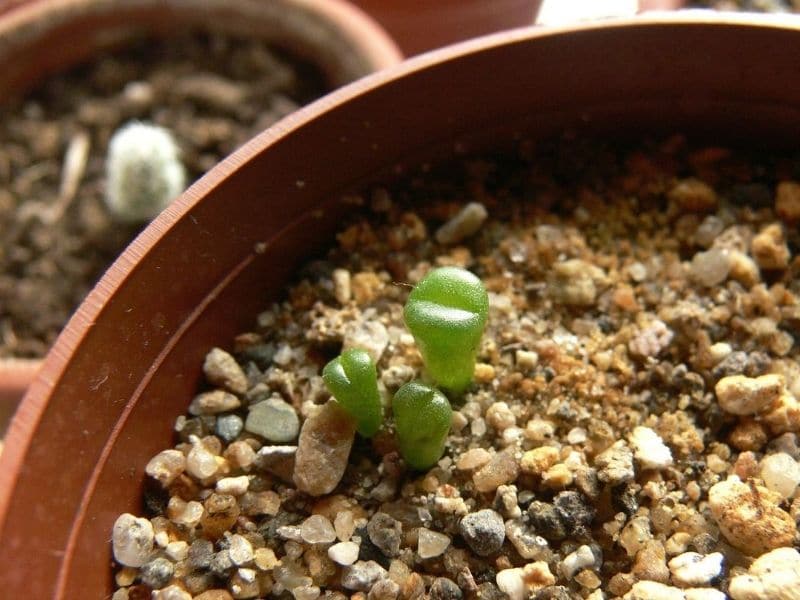
They should be sown in a sandy soil mix, like that for cacti with added sand, and covered in a thin layer of sand. Placed in a sunny location outdoors, the set up should be kept moist to allow the seeds to germinate after a couple of weeks. Watering should then be minimized when the seedlings start growing faster.
After 2-3 months, they should be left to dry out before watering again to avoid damping off or rotting. Once they are a year old, the young lithops can now be transplanted to individual pots. These pots should be 3-5 in deep to provide enough space for root growth. When transplanting, leave the top ¾ of the plant body above the soil.
Lithops are self-sterile so if the aim is to produce your own seeds, make sure that there are separate plants and that pollinators are available. The resulting fruit is a dry capsule that bursts when wet, revealing the tiny seeds that can remain viable for years (1).
Living stone plants look best planted in groups in a dish garden. This novelty house plant is commonly displayed intermixed with colorful rounded pebbles and stones to deceive the eyes of its audience.
Best Lithops Varieties You Can Grow
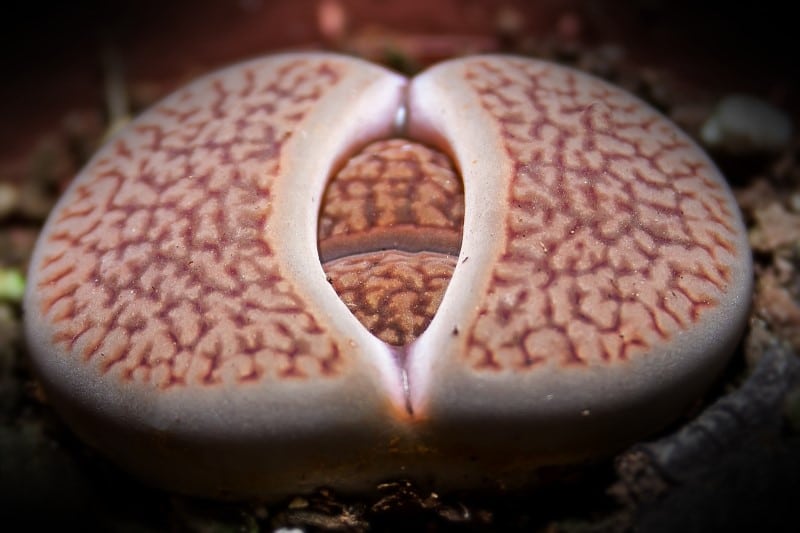
L. aucampiae
This lithops is reddish or sandy brown with dark marks on the top or upper panel of the leaves. The flower is yellow.
L. dorotheae
This species is beige in color with dark red marks on the upper panel and yellow flowers.
L. insularis
A greenish brown living stone, it has dark green patterns on top and produces yellow flowers.
L. julii
This lithops is gray with red tint and dotted brown marks. The flower is white.
L. karasmontana
A pale red brown species, this lithops has dark upper panel patterns and white flower.
L. optica ‘Rubra’
This variety is striking red with smooth deep red markings on top. The flower is white.
L. vallis-mariae
This living stone is yellowish to bluish white with dotted gray lines on the upper panel. The flower is yellow.
If you love growing lithops, you’ll definitely want to check out this lapidaria margaretae succulent. They look very unusual and would be an amazing choice to add to your collection.
References
Reference List
(1) Raider, S. The Biogeography of Living Stones. San Francisco State University. 1999. http://online.sfsu.edu/bholzman/courses/Fall99Projects/lithops.htm. Accessed 14 August 2020.
(2) Perry, L. Lithops. University of Vermont. http://pss.uvm.edu/pss123/suclith.html. Accessed 14 August 2020.
Close
Photo by PantherMediaSeller/depositphotos

